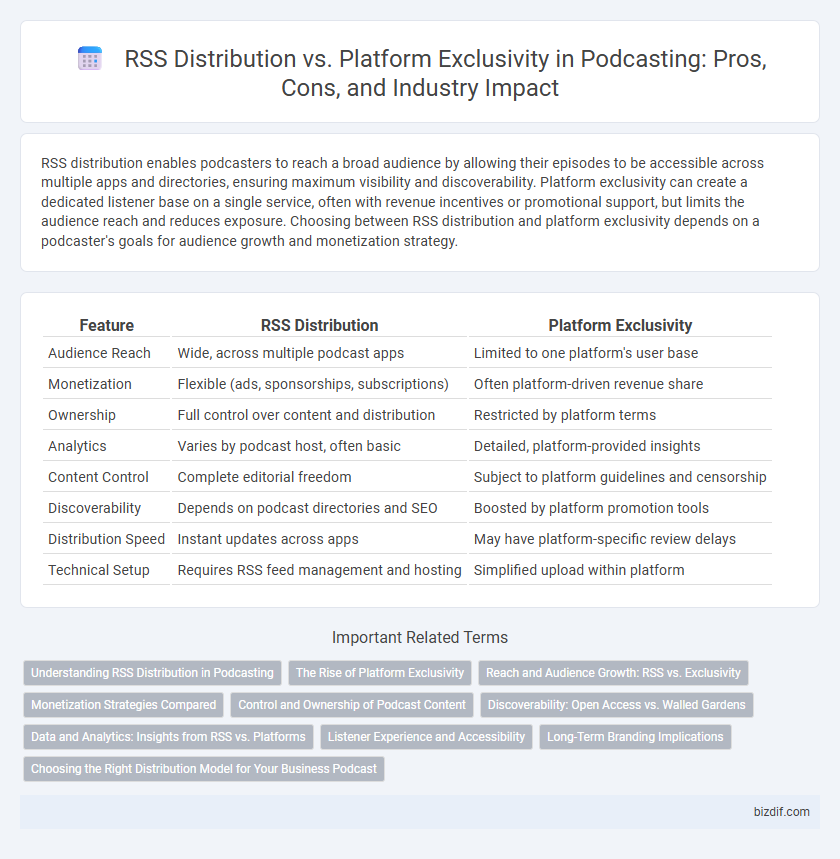RSS distribution enables podcasters to reach a broad audience by allowing their episodes to be accessible across multiple apps and directories, ensuring maximum visibility and discoverability. Platform exclusivity can create a dedicated listener base on a single service, often with revenue incentives or promotional support, but limits the audience reach and reduces exposure. Choosing between RSS distribution and platform exclusivity depends on a podcaster's goals for audience growth and monetization strategy.
Table of Comparison
| Feature | RSS Distribution | Platform Exclusivity |
|---|---|---|
| Audience Reach | Wide, across multiple podcast apps | Limited to one platform's user base |
| Monetization | Flexible (ads, sponsorships, subscriptions) | Often platform-driven revenue share |
| Ownership | Full control over content and distribution | Restricted by platform terms |
| Analytics | Varies by podcast host, often basic | Detailed, platform-provided insights |
| Content Control | Complete editorial freedom | Subject to platform guidelines and censorship |
| Discoverability | Depends on podcast directories and SEO | Boosted by platform promotion tools |
| Distribution Speed | Instant updates across apps | May have platform-specific review delays |
| Technical Setup | Requires RSS feed management and hosting | Simplified upload within platform |
Understanding RSS Distribution in Podcasting
RSS distribution enables podcasters to publish episodes directly to a universally accessible feed, ensuring content reach across multiple podcast platforms like Apple Podcasts, Spotify, and Google Podcasts. This open syndication model maximizes audience exposure, allowing listeners to subscribe via any RSS-compatible app, which promotes discoverability and subscriber growth. Unlike platform exclusivity, RSS distribution offers podcasters full control over their show's availability and metadata, fostering long-term audience retention and independence.
The Rise of Platform Exclusivity
Platform exclusivity in podcasting has surged as major streaming services secure exclusive rights to popular shows, driving listener traffic and advertiser investment directly to their ecosystems. This approach contrasts with traditional RSS distribution, which enables wider accessibility across diverse podcast apps but may dilute audience concentration and monetization opportunities. Exclusive content strategies enhance user retention and platform differentiation, reshaping podcast consumption and market dynamics.
Reach and Audience Growth: RSS vs. Exclusivity
RSS distribution enables broader reach by allowing podcasts to be available on multiple platforms, increasing audience growth potential through diverse discovery channels. Platform exclusivity limits a podcast's accessibility, often restricting audience expansion to a single or a few platforms with built-in loyal users but less overall exposure. Leveraging RSS feeds strategically amplifies visibility and maximizes audience acquisition by tapping into various directories, apps, and smart devices.
Monetization Strategies Compared
RSS distribution enables podcasters to reach diverse audiences across multiple platforms, maximizing ad revenue through broad listener access and dynamic ad insertion. Platform exclusivity often offers upfront sponsorship deals and subscription models, providing predictable income but limiting audience reach. Revenue potential varies by leveraging either wide distribution for scalable ads or exclusivity for premium content monetization.
Control and Ownership of Podcast Content
RSS distribution grants podcasters full control and ownership over their podcast content, enabling them to publish episodes independently and retain rights without platform restrictions. Platform exclusivity often limits creators' control by binding content to a single service, which can impose specific terms, monetization options, and audience access constraints. Maintaining RSS feeds ensures broader distribution flexibility, direct audience engagement, and the ability to monetize content without intermediary limitations.
Discoverability: Open Access vs. Walled Gardens
RSS distribution enables podcasts to reach a wider audience by allowing episodes to be accessed on multiple platforms and apps, enhancing discoverability through open access. Platform exclusivity limits access to a single ecosystem, often resulting in reduced audience reach but potentially higher monetization and control. Open RSS feeds foster greater visibility and audience growth by leveraging diverse directories, while walled gardens restrict discovery to the platform's existing user base.
Data and Analytics: Insights from RSS vs. Platforms
RSS distribution offers podcasters comprehensive data access by enabling direct integration with diverse analytics tools, presenting detailed listener demographics, geographic data, and behavior patterns. Platform exclusivity confines analytics within proprietary dashboards, often limiting raw data access and transparency while emphasizing user engagement metrics specific to that platform. Comparing both, RSS feeds empower deeper custom analysis, whereas exclusive platforms provide streamlined but restricted insights tailored to their ecosystem.
Listener Experience and Accessibility
RSS distribution ensures wide accessibility by allowing listeners to choose any podcast app, enhancing user control and discovery. Platform exclusivity limits accessibility, often requiring specific apps or accounts, which can hinder listener convenience and reduce exposure. For the best listener experience, open RSS feeds promote seamless content access across multiple devices and platforms.
Long-Term Branding Implications
RSS distribution ensures widespread availability of podcasts across multiple platforms, maximizing audience reach and sustaining consistent brand exposure over time. Platform exclusivity may drive short-term subscriber growth but limits long-term brand visibility due to restricted access and dependence on a single ecosystem. Maintaining RSS distribution supports enduring audience engagement and solidifies a podcast's brand identity in diverse listening environments.
Choosing the Right Distribution Model for Your Business Podcast
Selecting the right distribution model for your business podcast involves weighing the broad reach of RSS feed distribution against the targeted audience engagement of platform exclusivity. RSS feeds enable automatic syndication across multiple podcast directories like Apple Podcasts, Spotify, and Google Podcasts, maximizing listener accessibility and discoverability. Platform exclusivity can foster a dedicated audience and potential monetization opportunities, but it may limit audience growth and restrict cross-platform sharing essential for brand expansion.
RSS distribution vs platform exclusivity Infographic

 bizdif.com
bizdif.com